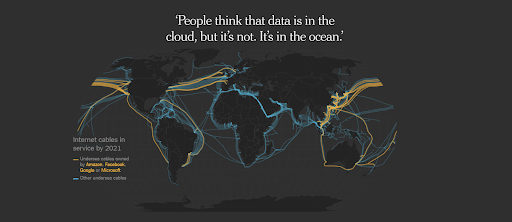We discuss the following topics in this blog:
- Understanding how glass fibres are shaping the internet we see today
- Internet becoming the new essential
- The New ‘Industrial Revolution’ is here to stay
- STL’s end-to-end Opticonn solutions
In addition to these topics, we shall also be answering the following FAQs:
- What is WiFi?
- What is an Optical Fibre Cable?

Contents
Overview
When we think of the internet of today, we usually think of 5G, Starlink, WiFi 6 and much more. But do we really understand what all goes behind this to make it all work in symphony. To put things into perspective 750,000 miles of fiber optic cables are currently running under our oceans. Thin, tiny durable strands of glass that carry your photos, emails, video calls and potentially everything we see on the internet.
Bits of code or to be precise your data zips from Australia to India and back,in the time it takes you to read this sentence. It all dates back to a 5000 year old material called glass that has always helped humanity to harness the true potential of technology. We do not think about living in a wired world, we think about living in a wireless world and most people think where is the fibre in all this.
To understand this better we first need to figure out how the internet works. Let’s say you have your phone or tablet and you are constantly downloading and uploading data. This information is being sent wirelessly using microwaves to a local router or a cell tower, from here everything goes in the form of electrons to a centralised hub. This information is then converted into light and propagated all across the world through a fibre optic cable.

Before we go any further, let’s brush up some basics first
What is an Optical Fibre in the First Place?
Optical fibre is a thin, flexible, strand-like material made of pure glass, through which light signals or data can be sent over longer distances at faster speeds. A strand of fibre 1/10th the thickness of human hair. An optical fibre has three layers. The core is the innermost area through which the light travels. Cladding is another layer of glass wrapped on the outside of the core. Its job is to keep the light signal inside the core. Coatings are multi-layers of plastics applied to preserve strength, absorb shock and protect it from environmental changes.

Fig 2 Optical Fibre MM Vs SM, Working of Optical Fibre Source: Multiple
Light in OF travels through the core by constantly bouncing off from the cladding. This happens because the cladding doesn’t absorb any light from the core and bounces off all the light back to the core. We might expect a beam of light to leak out of edges but when light hits another glass-like clad, which has a lower refractive index than the core, it acts as a mirror and the light gets reflected back to the core leading to Total Internal Reflection. Total internal reflection is absolutely critical for the functioning of the optical fibre.
For TIR to occur the following conditions need to be met – First, light is travelling from a denser (High RI) medium to a rarer (Low RI) medium. Hence the refractive index of the core is kept higher than the clad. Second, AOI should be greater than the critical angle.
There are 2 types of optical fibres Single-mode and Multi-mode – in SM fibre, only one mode or ray of light is allowed to pass through the core. Hence the core is smaller in diameter, around 9 microns. MM fibre allows more than one mode or ray of light to pass through it. It has a wider core diameter of 62.5 microns. SM fibre is less expensive, has low loss of strength or attenuation, and can be used for longer distances. Single-mode is the most widely used fibre type.
Here Comes our Real Hero – The INTERNET
While this has been a challenging year, the telecommunications and technology industry has stood up to the occasion and enabled us in keeping businesses, governments, and societies connected and running. Just to put things into perspective, the world has seen more than 1 million new Internet users adopt a digital lifestyle from the comfort of their homes each day.The Internet and data are now so all-pervasive and ubiquitous that it can be safely considered as the fourth utility, alongside water, gas, and electricity.
As the world adapts to these changes, we are seeing substantial shifts in usage patterns and traffic in five key ways: which will continue even post the current situation.
- from predominantly entertainment to enterprises and cloud use cases,
- from download only to symmetric uploads and downloads – boosted by video conferencing,
- from asynchronous to real-time use cases, requiring instantaneous response time, and
- from office networks to ever increasing home networks usage
- an increase in traffic by 60-70% in the past few months.
To conclude:
a) Technology is set to bring humanity together – to collaborate and transform the everyday lives of billions.
b) To get there, we need an ecosystem of like-minded futurists, digital network creators – Telecom companies, Cloud companies, Governments, and Private Enterprises – to work together in an integrated manner.
c) We have the opportunity of a lifetime and the responsibility to deliver the Internet for the world.
The Changing Work, Workers and Workplaces
- Age of digital-first companies – More than ever, businesses are now moving towards a new ‘low-touch’ model where customers are making purchase decisions with the help of their devices and AI assistance.
- The new Regulatory Landscape – Govts and Regulators need to quickly align with these technologies to empower the Gig economy. At the same time with the current rate of disruption regulated innovation is something that is of utmost importance
- Technology, Talent and Transformation – Automation is set to be the next driver of growth and adaptation is needed at every step. From AR/VR everything to AI powered devices, the shift to digital is certain. For eg 48% of employees will likely work remotely at least part of the time after COVID-19 versus 30% before the pandemic.
- Harnessing the unleashed workforce – Organizations will leverage big-tech, giving rise to resource-on-demand for harnessing a new mix of talent.
- New culture of learning – As routine work is automated we will be able to focus more truly on human skills. Careers around skills will precede Careers around jobs.
STL’s End-to-End Opticonn solutions Connecting millions in the Land Down Under
STL, an industry-leading integrator of digital networks, recently announced a partnership with Vocus Group, a specialist fibre and network solutions provider in Australia. This deal strengthens STL’s presence in the Australian market, helping network creators deploy high capacity nationwide networks faster.
Vocus Group Limited (ASX: VOC) is Australia’s specialist fibre and network solutions provider, connecting all mainland capitals with Asia and the USA. Regionally, Vocus has backhaul fibre connecting most regional centres in Australia. Vocus also operates an extensive and modern network in New Zealand, connecting the country’s capitals and most regional centres.
In total, the Vocus terrestrial network is c.30,000 route-km of high performance, high availability fibre-optic cable, including 4,600km of submarine cable connecting Singapore, Indonesia and Australia and 2,100km of submarine cable between Port Hedland and Darwin and connecting offshore oil and gas facilities in the Timor Sea. Vocus owns a portfolio of well-recognised brands catering to enterprise, government, wholesale, small business and residential customers across Australia and New Zealand.
Vocus will leverage STL’s Opticonn solution, which offers a range of optical fibre and cable products, optical interconnect offerings and pre-connectorized kits.
FAQs
What is WiFi?
Put simply, WiFi is a technology that uses radio waves to create a wireless network through which devices like mobile phones, computers, printers, etc., connect to the internet. A wireless router is needed to establish a WiFi hotspot that people in its vicinity may use to access internet services. You’re sure to have encountered such a WiFi hotspot in houses, offices, restaurants, etc.
To get a little more technical, WiFi works by enabling a Wireless Local Area Network or WLAN that allows devices connected to it to exchange signals with the internet via a router. The frequencies of these signals are either 2.4 GHz or 5 GHz bandwidths. These frequencies are much higher than those transmitted to or by radios, mobile phones, and televisions since WiFi signals need to carry significantly higher amounts of data. The networking standards are variants of 802.11, of which there are several (802.11a, 802.11b, 801.11g, etc.).
What is an Optical Fibre Cable?
An optical fibre cable is a cable type that has a few to hundreds of optical fibres bundled together within a protective plastic coating. They help carry digital data in the form of light pulses across large distances at faster speeds. For this, they need to be installed or deployed either underground or aerially. Standalone fibres cannot be buried or hanged so fibres are bunched together as cables for the transmission of data. This is done to protect the fibre from stress, moisture, temperature changes and other externalities.
There are three main components of a optical fibre cable, core (It carries the light and is made of pure silicon dioxide (SiO2) with dopants such as germania, phosphorous pentoxide, or alumina to raise the refractive index; Typical glass cores range from as small as 3.7um up to 200um), Cladding (Cladding surrounds the core and has a lower refractive index than the core, it is also made from the same material as the core; 1% refractive index difference is maintained between the core and cladding; Two commonly used diameters are 125µm and 140µm) and Coating (Protective layer that absorbs shocks, physical damage and moisture; The outside diameter of the coating is typically either 250µm or 500µm; Commonly used material for coatings are acrylate,Silicone, carbon, and polyimide).
An optical fibre cable is made up of the following components: Optical fibres – ranging from one to many. Buffer tubes (with different settings), for protection and cushioning of the fibre. Water protection in the tubes – wet or dry. A central strength member (CSM) is the backbone of all cables. Armoured tapes for stranding to bunch the buffer tubes and strength members together. Sheathing or final covering to provide further protection.
The five main reasons that make this technology innovation disruptive are fast communication speed, infinite bandwidth & capacity, low interference, high tensile strength and secure communication. The major usescases of optical fibre cables include intenet connectivity, computer networking, surgery & dentistry, automotive industry, telephony, lighting & decorations, mechanical inspections, cable television, military applications and space.













